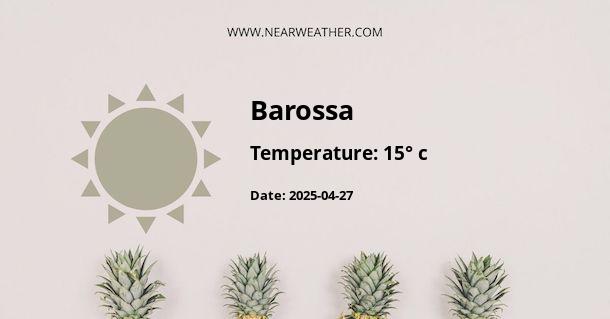The Climate and Weather in Barossa, Australia
Barossa is a renowned wine-producing region located in South Australia, known for its picturesque landscapes and world-class vineyards. The region experiences a Mediterranean climate, characterized by warm, dry summers and cool, wet winters. Let's explore the climate and weather patterns of Barossa throughout the year.
Seasonal Overview
The following table provides a summary of the average temperature and precipitation levels in Barossa for each season:
| Season | Temperature | Precipitation |
|---|---|---|
| Summer (December - February) | Highs in the mid to high 30s °C (95-104 °F), Lows in the mid-teens to low 20s °C (59-68 °F) | Low, occasional thunderstorms |
| Autumn (March - May) | Mild, with highs in the low 20s °C (68-77 °F), Lows in the single digits to low teens °C (40-55 °F) | Moderate, occasional rainfall |
| Winter (June - August) | Cool, with highs in the mid-teens to low 20s °C (59-68 °F), Lows in the single digits to low teens °C (40-55 °F) | Higher, steady rainfall |
| Spring (September - November) | Mild to warm, with highs in the low to mid 20s °C (68-77 °F), Lows in the single digits to low teens °C (40-55 °F) | Moderate, occasional rainfall |
Summer Weather
During the summer months in Barossa, the weather is hot and dry, with temperatures often reaching the mid to high 30s °C (95-104 °F). The region experiences long, sunny days, making it an ideal time for outdoor activities and wine tasting. However, occasional thunderstorms can provide relief from the heat and contribute to the growth of vineyards.
Winter Weather
Winter brings cooler temperatures to Barossa, with highs in the mid-teens to low 20s °C (59-68 °F). The region experiences steady rainfall during this time, which is essential for the health of the vineyards. The picturesque landscape takes on a green hue, creating a beautiful backdrop for wine tours and tastings.
Rainfall Patterns
Barossa receives the majority of its annual rainfall during the winter months, with June being the wettest month. The region experiences moderate and occasional rainfall during autumn and spring, contributing to the overall health of the vineyards and agricultural landscape.
Climate Considerations for Wine Production
The Mediterranean climate of Barossa is well-suited for wine production, particularly for the cultivation of Shiraz, one of the region's flagship grape varieties. The distinct seasonal variations in temperature and rainfall contribute to the complex flavors and quality of the wines produced in Barossa.
Conclusion
Barossa's Mediterranean climate provides the ideal environment for wine production, with distinct seasonal variations contributing to the unique flavors of the region's wines. Whether visiting in the summer to experience the long, sunny days or in the winter to appreciate the lush green landscape, Barossa offers a rich and diverse experience for wine enthusiasts and tourists alike.
With its warm summers and cool, wet winters, Barossa's climate is integral to its identity as a world-class wine region. The distinct seasonal variations in temperature and rainfall contribute to the complex flavors and quality of the wines produced in Barossa. Whether visiting in the summer to experience the long, sunny days or in the winter to appreciate the lush green landscape, Barossa offers a rich and diverse experience for wine enthusiasts and tourists alike.A - Barossa's Latitude is -34.613510 & Longitude is 138.961685.
A - Weather in Barossa is 15° today.
A - Climate Conditions in Barossa shows few clouds today.
A - Humidity in Barossa is 68% today.
A - Wind speed in Barossa is 12.74 km/h, flowing at 189° wind direction. today.
